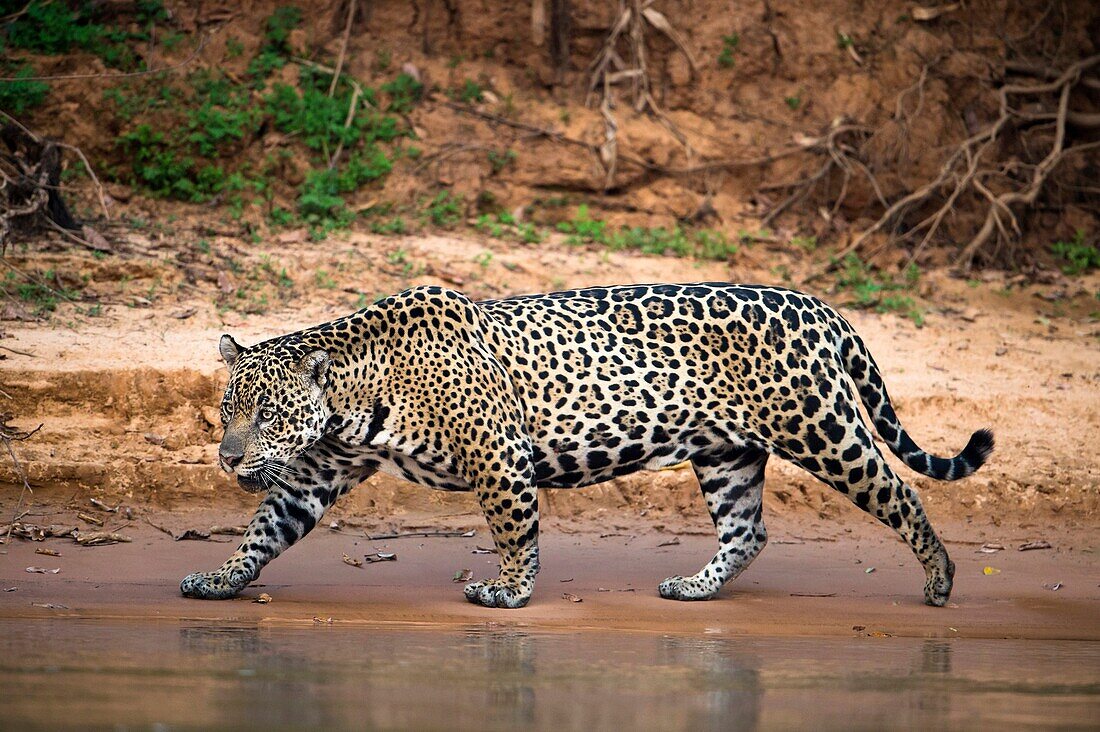The jaguar is a strong and mysterious big cat known for its beauty and hunting skills. With its golden coat and black spots, the jaguar is one of the most powerful animals in the rainforest. It is calm, clever, and often moves quietly through thick forests.
Scientific Classification
-
Kingdom: Animalia
-
Phylum: Chordata
-
Class: Mammalia
-
Order: Carnivora
-
Family: Felidae
-
Genus: Panthera
-
Species: Panthera onca
Common Names
-
Jaguar
-
El Tigre (in some Spanish-speaking countries)
-
Panther (when black in color)
-
Painted Cat
Geographic Distribution
Jaguars are mostly found in:
-
Central and South America
-
Especially in Brazil, Venezuela, Colombia, and Peru
-
Some parts of Mexico
They live in:
-
Dense rainforests
-
Swamps and riverbanks
-
Sometimes dry woodlands
 Image showing a Jaguar walking beside a jungle river (Source: lookphotos)
Image showing a Jaguar walking beside a jungle river (Source: lookphotos)
Physical Characteristics
-
Size: 1.1 to 1.8 meters (head to body)
-
Weight: 45 to 100 kg
-
Color: Yellowish-golden with black rosettes (spot patterns)
-
Build: Muscular body, short legs, broad head
-
Special Trait: Extremely strong jaw, can bite through bones and turtle shells
Jaguar Behavior
-
Solitary, prefers to live alone
-
Active during day and night (mostly at dawn or dusk)
-
Great swimmer, enjoys water unlike most cats
-
Marks territory with scent and scratch marks
-
Climbs trees but mostly hunts on ground
What do Jaguars eat?
Jaguars are carnivores, meaning they eat only meat. Their diet includes:
-
Deer
-
Wild pigs
-
Capybaras
-
Turtles and fish
-
Monkeys, birds, and even caimans
They are ambush hunters, silently stalking prey before a surprise attack.
Fun facts about Jaguars
-
The name “jaguar” comes from a Native American word meaning “he who kills with one leap.”
-
Jaguars have the strongest bite of all big cats, even stronger than lions.
-
Black jaguars are often called black panthers, the black coat hides their spots.
-
Unlike most cats, jaguars love water and often swim across rivers.
-
They don’t just chase, they wait and strike when prey least expects.
Importance to Humans
Positive Roles:
-
Symbol of strength in many cultures
-
Attracts tourists and researchers
-
Helps control populations of smaller animals
-
Seen in art, myths, and stories in Latin America
Challenges:
-
Sometimes killed by farmers protecting livestock
-
Habitat loss due to logging and farms
-
Illegal hunting for their fur
Health & common issues (in Zoos or Rescue)
Jaguars in the wild rarely suffer from disease, but those in zoos or rescue centers may face:
Common Issues:
-
Obesity (if not exercised)
-
Stress from small enclosures
-
Dental problems (from biting hard bones)
-
Parasites and infections
Care Tips:
-
Large space for roaming and swimming
-
Enrichment activities to stay active
-
Clean meat and regular vet checks
-
Calm, quiet environment
Conservation Status
-
Jaguars are listed as “Near Threatened” by the IUCN
-
Numbers are decreasing in many regions
Main threats:
-
Deforestation and habitat loss
-
Poaching for fur and body parts
-
Conflicts with humans (livestock attacks)
Many wildlife groups are now protecting jaguar habitats and teaching communities how to live safely with wild cats.
Jaguar vs Leopard
| Feature | Jaguar | Leopard |
|---|---|---|
| Location | Americas | Africa and Asia |
| Size | Bigger and more muscular | Smaller and slimmer |
| Spots | Rosettes with dots inside | Rosettes without dots inside |
| Bite Strength | Very strong, crushes skulls | Strong, but not as powerful |
| Love for Water | Yes | Rarely |
 Image showing a black jaguar resting on a tree branch (Source:i Stock)
Image showing a black jaguar resting on a tree branch (Source:i Stock)
If you want to learn more about big cats or support wildlife protection, you can visit Doctor Hulk Veterinary Hospital or call 08143397614.














Reviews
There are no reviews yet.